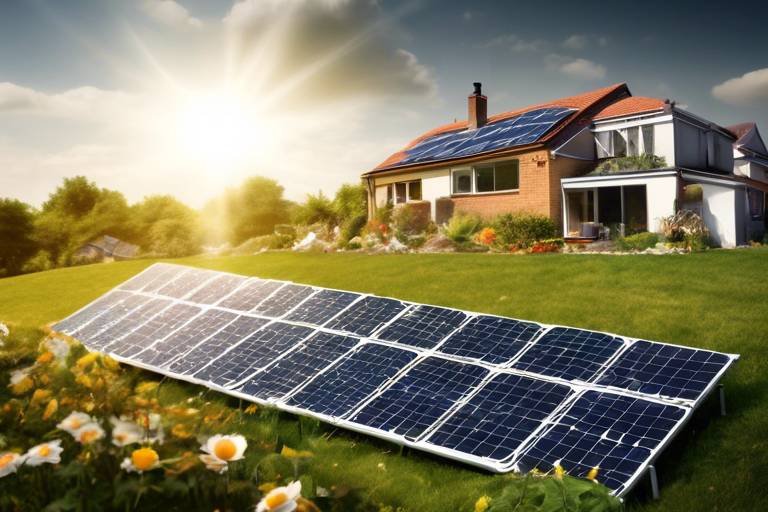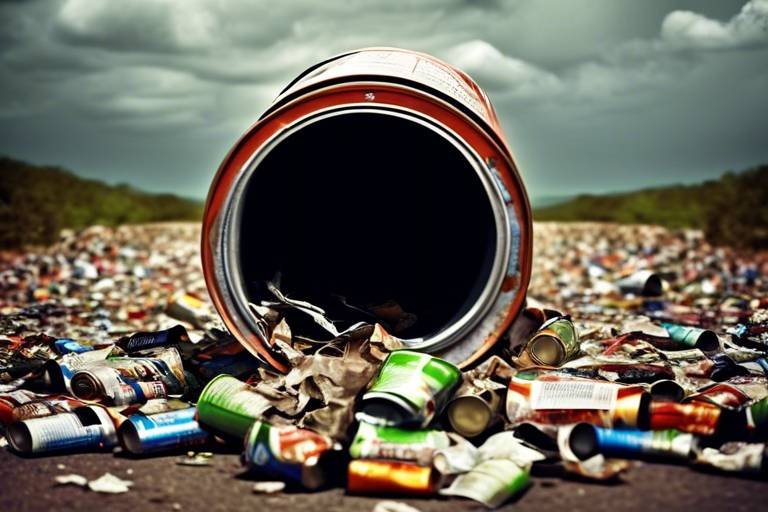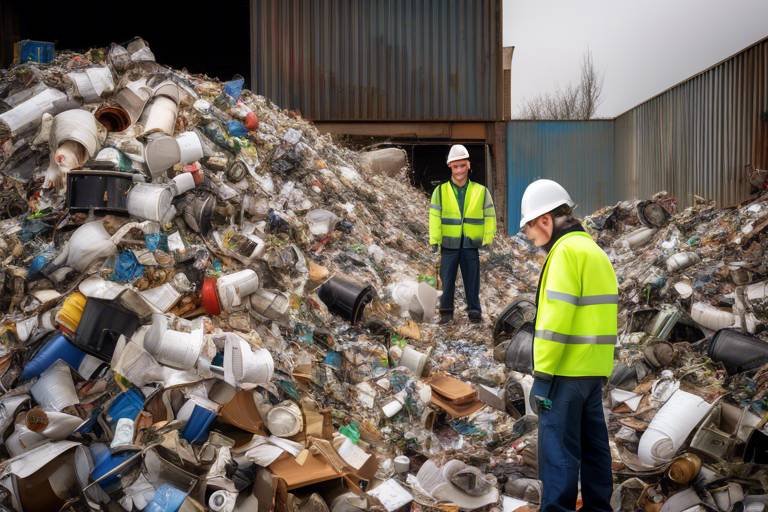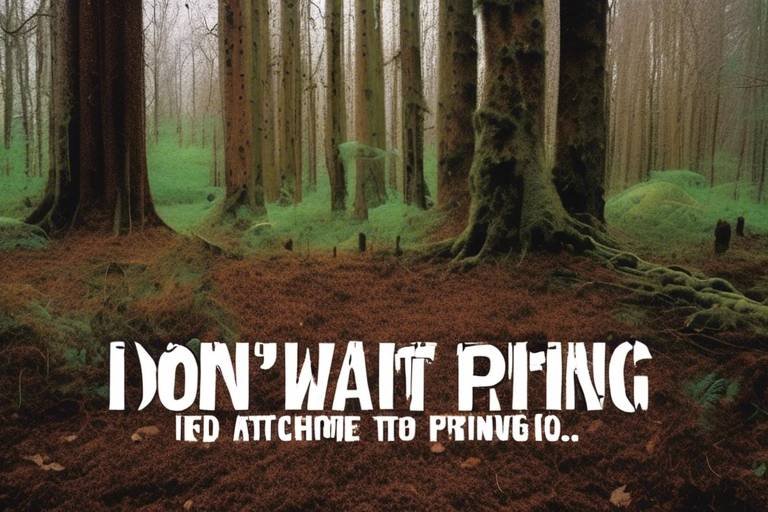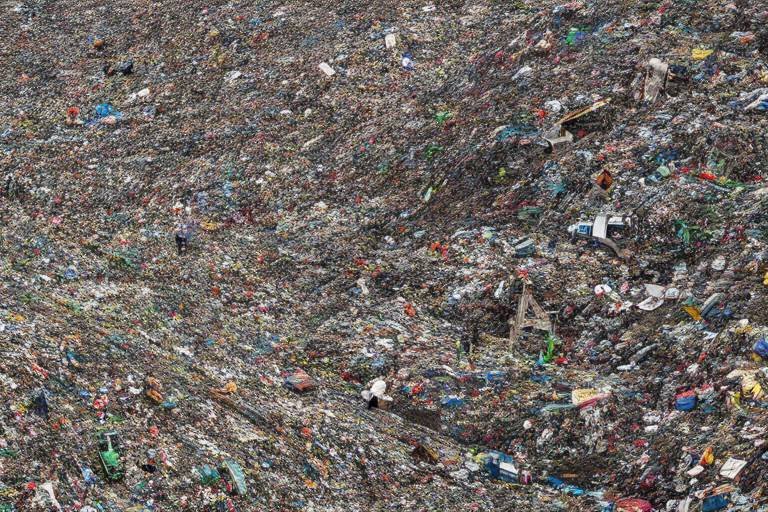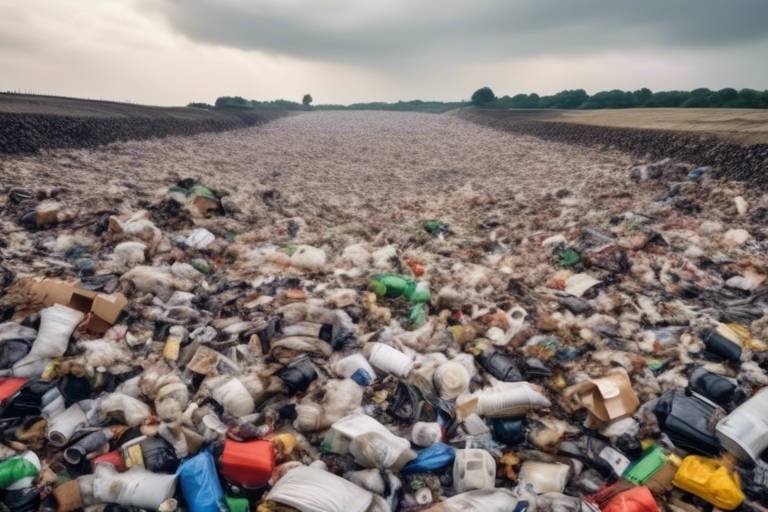The Effect of Composting on Soil Health
Composting is more than just a trendy gardening practice; it's a transformative process that significantly enhances soil health. By breaking down organic materials, composting creates a nutrient-rich amendment that revitalizes the soil, making it a powerhouse for plant growth. Imagine your garden as a living organism—just like us, it needs food, care, and a healthy environment to thrive. When you compost, you are essentially feeding your garden with the best kind of nutrition, resulting in vibrant plants and robust ecosystems.
So, what exactly does composting do for soil health? To start, it introduces a plethora of beneficial microorganisms into the soil. These tiny allies work tirelessly to break down organic matter, releasing essential nutrients in a form that plants can easily absorb. Think of them as the unsung heroes of your garden, tirelessly working behind the scenes to ensure everything runs smoothly. The result? Rich, loamy soil that can hold moisture, improve drainage, and support a diverse range of plant life.
Moreover, composting enhances the structure of the soil. When organic matter decomposes, it forms aggregates that improve aeration and water retention. This is crucial because healthy soil needs to be able to breathe and absorb water effectively. Without proper structure, soil can become compacted, leading to poor drainage and root development. By adding compost, you’re essentially fluffing up your soil, allowing roots to spread and access nutrients more easily.
Another remarkable effect of composting is its ability to increase nutrient availability. Compost is a treasure trove of macronutrients like nitrogen, phosphorus, and potassium, as well as micronutrients that plants crave. When you incorporate compost into your soil, you’re not just adding bulk; you’re enriching it with a balanced mix of nutrients that can lead to healthier, more productive plants. This means fewer chemical fertilizers and a lower risk of nutrient runoff, which can harm local waterways.
Additionally, composting boosts microbial activity in the soil. A thriving microbial community is essential for breaking down organic matter and cycling nutrients. The more diverse your soil's microbial life, the better it can respond to environmental changes and stressors. This resilience is vital, especially in a world where climate change poses challenges to agriculture and ecosystems alike.
In summary, the effects of composting on soil health are profound and multifaceted. By enriching the soil with organic matter, enhancing its structure, and fostering a vibrant microbial community, composting not only supports plant health but also contributes to a sustainable environment. Whether you’re a seasoned gardener or just starting, incorporating compost into your soil management practices is a step towards a healthier, more productive garden.
- What materials can I compost? Most kitchen scraps like fruit and vegetable peels, coffee grounds, and eggshells are great options, along with yard waste like leaves and grass clippings.
- How long does it take to make compost? Depending on the method used, compost can take anywhere from a few weeks to several months to fully decompose.
- Can composting help with soil erosion? Yes, compost improves soil structure, which can help reduce erosion by promoting better water absorption and root growth.
- Is composting difficult to do? Not at all! With a little knowledge and the right materials, anyone can start composting.
Understanding Soil Health
Soil health is more than just a buzzword in the world of agriculture and environmental science; it's the very foundation of our ecosystems and food systems. But what exactly does it mean? Simply put, soil health refers to the capacity of soil to function as a living ecosystem that sustains plants, animals, and humans. Healthy soil is rich in organic matter, has a diverse community of microorganisms, and possesses the right physical and chemical properties to support plant growth.
When we talk about soil health, we are looking at several key components:
- Soil Structure: This refers to the arrangement of soil particles and the spaces between them. Good soil structure allows for air and water movement, which is vital for plant roots and soil organisms.
- Nutrient Availability: Healthy soil provides essential nutrients like nitrogen, phosphorus, and potassium. These nutrients are necessary for plant growth and development.
- Microbial Activity: A thriving community of microorganisms, including bacteria, fungi, and protozoa, is crucial for breaking down organic matter and cycling nutrients.
- pH Levels: The acidity or alkalinity of soil can influence nutrient availability and microbial activity, which in turn affects plant health.
Maintaining soil health is not just important for farmers; it has broader implications for our environment. Healthy soil can:
- Enhance water retention, reducing the need for irrigation.
- Prevent erosion and promote biodiversity.
- Sequester carbon, helping to mitigate climate change.
In the quest for sustainable farming practices, understanding soil health is vital. It’s like nurturing a garden; if you want vibrant flowers, you must first cultivate the soil. Just as a chef relies on fresh ingredients for a delicious meal, farmers depend on healthy soil to grow nutritious crops. Without a focus on soil health, we risk depleting our natural resources and compromising food security for future generations.
So, how do we assess soil health? Various tests can be conducted to evaluate the physical, chemical, and biological aspects of soil. These tests help in identifying deficiencies and determining the best practices for soil management. By regularly monitoring soil health, we can make informed decisions that contribute to sustainable agriculture and a healthier planet.
In summary, soil health is a complex interplay of various factors that support life on Earth. By understanding and prioritizing soil health, we not only enhance agricultural productivity but also contribute to a more sustainable and balanced ecosystem.
The Composting Process
Composting is not just a trendy buzzword; it's a natural process that transforms organic waste into a valuable resource for enriching soil health. At its core, composting involves the decomposition of organic matter, such as kitchen scraps, yard waste, and even paper products, through the action of microorganisms. Think of it as nature's recycling program, where waste is turned into a nutrient-rich amendment that benefits plants and the environment alike.
The composting process begins with the collection of materials. You can use a variety of organic materials, often categorized into two main types: greens and browns. Greens include nitrogen-rich items like fruit and vegetable scraps, coffee grounds, and grass clippings, while browns consist of carbon-rich materials such as dried leaves, straw, and cardboard. Balancing these two types is essential for efficient composting. The ideal ratio is generally around 2:1 of browns to greens, creating a well-aerated mixture that allows microorganisms to thrive.
Once your materials are gathered, the next step is to create a compost pile or bin. This is where the magic happens! The pile needs to be aerated, which can be done by turning it regularly with a pitchfork or shovel. This aeration is crucial because it allows oxygen to circulate, promoting the growth of aerobic bacteria that speed up the decomposition process. A well-maintained compost pile can reach temperatures of 130°F to 160°F (54°C to 71°C), which helps kill off pathogens and weed seeds. It's like giving your compost a cozy blanket to keep it warm!
For successful composting, there are a few key conditions to keep in mind:
- Moisture: The compost pile should be kept damp, similar to a wrung-out sponge. Too much moisture can lead to anaerobic conditions, while too little can slow down decomposition.
- Temperature: As mentioned, the internal temperature of the compost pile is vital. Monitoring the temperature can help you know when to turn the pile to maintain optimal conditions.
- Particle Size: Chopping or shredding materials into smaller pieces can enhance decomposition speed, as it increases the surface area for microorganisms to work on.
As the microorganisms break down the organic matter, they produce heat, which further accelerates the composting process. Over time, you’ll notice a transformation in the materials as they shrink, darken, and develop a rich, earthy smell. This process can take anywhere from a few weeks to several months, depending on factors like temperature, moisture, and the materials used. When the compost is ready, it should resemble dark, crumbly soil, free of any recognizable organic material.
Composting can be a rewarding endeavor, not just for the environment but also for your garden. It’s a way to reduce waste, save money on fertilizers, and create a thriving ecosystem in your backyard. So, whether you’re a seasoned gardener or just starting, embracing composting can lead to a healthier garden and a healthier planet.
Types of Composting
When it comes to composting, there isn't a one-size-fits-all approach. Just like cooking, different recipes yield different results, and the same goes for composting methods. Each method has its unique benefits and is suited for various needs and environments. Understanding the different types of composting can help you choose the best method for your gardening or farming needs.
One of the most popular methods is hot composting. This technique involves creating a compost pile that generates heat through the decomposition of organic materials. The heat accelerates the breakdown of the materials, allowing for faster compost production. Ideally, the temperature of the pile should reach between 130°F to 160°F (54°C to 71°C) to effectively kill off pathogens and weed seeds. Hot composting is perfect for those who want quick results and are willing to invest a bit of effort into managing the pile.
On the flip side, we have cold composting, which is a more laid-back approach. This method involves simply piling up organic waste and letting it decompose over time without the need for turning or monitoring temperatures. It’s less labor-intensive and can be a great option for those who prefer a more hands-off approach. However, it does take longer for the compost to mature, often several months to a year. Cold composting is ideal for those who are patient and want to gradually improve their soil health.
Another fascinating method is vermicomposting, which utilizes worms to break down organic matter. Worms are nature’s little recyclers, and they can turn kitchen scraps and yard waste into nutrient-rich compost known as worm castings. This method not only speeds up the composting process but also enhances the nutrient profile of the compost. Vermicomposting is especially beneficial for urban gardeners who may have limited space, as it can be done in small bins indoors or outdoors.
Here's a quick comparison of these composting methods:
| Composting Method | Time to Compost | Labor Intensity | Best For |
|---|---|---|---|
| Hot Composting | 2-3 months | High | Quick results |
| Cold Composting | 6 months - 1 year | Low | Patience required |
| Vermicomposting | 1-3 months | Medium | Indoor gardening |
In summary, the type of composting you choose can significantly impact your gardening experience and the health of your soil. Whether you prefer the quick results of hot composting, the low-maintenance approach of cold composting, or the nutrient-rich benefits of vermicomposting, there’s a method out there that perfectly suits your needs. So, which one will you try?
Hot Composting
Hot composting is an exciting and efficient method of composting that takes advantage of the natural heat generated during the decomposition of organic matter. This process is not just about throwing scraps into a pile; it’s a carefully orchestrated dance between microorganisms, moisture, and oxygen. When you create a hot compost pile, you’re essentially creating an ecosystem that works tirelessly to break down your kitchen waste, yard clippings, and other organic materials into nutrient-rich compost.
One of the key aspects of hot composting is the temperature. For a compost pile to be considered “hot,” it typically needs to reach temperatures between 130°F and 160°F (54°C to 71°C). This heat is generated by the microbial activity breaking down the organic matter. The higher temperatures not only speed up the decomposition process but also help to kill off pathogens and weed seeds that might be lurking in your compost materials. It’s like giving your compost a warm bath, ensuring it’s clean and healthy!
To achieve and maintain these high temperatures, there are several factors to consider:
- Material Balance: A successful hot compost pile requires a balanced mix of green materials (like fruit scraps and grass clippings) and brown materials (such as dried leaves and cardboard). This balance is crucial because greens provide nitrogen, while browns supply carbon, both of which are essential for microbial growth.
- Moisture Level: The compost pile should be moist but not soggy. Think of it as a damp sponge—too dry, and the microbes will slow down; too wet, and you risk creating anaerobic conditions that can lead to unpleasant odors.
- Oxygen Supply: Turning the pile regularly is vital to keep the microbes happy. This aeration process introduces oxygen, which is essential for aerobic decomposition and helps maintain those high temperatures.
Hot composting can yield finished compost in as little as 4 to 8 weeks, depending on the materials used and the conditions maintained. This is significantly faster than cold composting, which can take several months to over a year. The quick turnaround makes hot composting particularly attractive for gardeners and farmers who want to enrich their soil without a long wait.
Moreover, the benefits of hot composting extend beyond just speed. The heat generated during the process can help break down tough materials like woody stems and branches, making them compostable. Additionally, the resulting compost is often richer in nutrients and has a finer texture, making it a fantastic amendment for your garden beds or potted plants.
In summary, hot composting is a dynamic and rewarding method of composting that not only speeds up the decomposition process but also enhances the quality of the compost produced. By understanding the science behind it and paying attention to the key factors—material balance, moisture, and oxygen—you can create a thriving compost pile that benefits both your garden and the environment.
Vermicomposting
When you think of composting, you might picture piles of leaves and kitchen scraps, but have you ever considered the incredible world of ? This method takes composting to a whole new level by enlisting the help of worms. Yes, you heard that right! These little wrigglers are not just garden pests; they are nature's very own recyclers, breaking down organic matter and turning it into nutrient-rich compost that your plants will absolutely love.
So, how does vermicomposting work? It’s quite simple, really. You create a cozy home for worms—usually red wigglers—within a bin filled with organic materials. These materials can include fruit and vegetable scraps, coffee grounds, and even shredded paper. As the worms munch away on this organic matter, they produce castings, which are essentially worm poop, rich in nutrients like nitrogen, phosphorus, and potassium. This process not only helps reduce waste but also creates a fertilizer that is often more effective than traditional compost.
One of the standout benefits of vermicomposting is its ability to produce compost in a relatively short amount of time. While traditional composting can take several months, vermicomposting can yield finished compost in just a few weeks. This makes it an attractive option for those who want quick results without sacrificing quality. Additionally, the compost produced through vermicomposting is known for its high microbial activity, which is essential for plant health. The worms also help aerate the compost, ensuring that it remains well-structured and free of compacted areas.
Moreover, vermicomposting is incredibly versatile. You can set up a vermicomposting bin in your kitchen, garage, or even your backyard. It’s a fantastic project for families, schools, or anyone interested in sustainability. Plus, it’s an excellent way to teach children about the importance of recycling and caring for the environment. Imagine their delight as they watch worms transform kitchen scraps into a rich, dark compost that they can use to nourish plants!
However, like all good things, vermicomposting comes with its own set of considerations. For instance, it’s important to maintain the right balance of materials in the bin. Too much food waste can lead to odors and unwanted pests, while too little can starve the worms. Ideally, you want to keep a mix of green materials (like vegetable scraps) and brown materials (like cardboard or dried leaves) to create a balanced diet for your worms. A good rule of thumb is to follow the 75-25 rule: 75% browns and 25% greens.
In conclusion, vermicomposting is not just a fun and engaging way to compost; it’s also a highly effective method for enhancing soil health. By harnessing the power of worms, you can create a sustainable cycle of waste reduction and nutrient replenishment that benefits both your garden and the environment. So, why not give it a try? Your plants—and the planet—will thank you!
- What types of worms are best for vermicomposting? Red wigglers (Eisenia fetida) are the most commonly used worms for vermicomposting due to their efficiency in breaking down organic matter.
- Can I use any type of food waste in my vermicomposting bin? While most vegetable scraps and fruit peels are fine, it’s best to avoid meat, dairy, and oily foods as they can attract pests and create odors.
- How often should I feed my worms? You can feed your worms every few days, but be sure to monitor their consumption and adjust based on how quickly they are eating.
- What do I do if my vermicomposting bin smells? If you notice unpleasant odors, it may be due to overfeeding or too much moisture. Check the balance of greens and browns, and ensure proper aeration.
Benefits of Composting for Soil
Composting is like giving your soil a superfood boost! When organic materials break down, they transform into nutrient-rich compost that can work wonders for soil health. The benefits of composting extend far beyond just recycling kitchen scraps or yard waste; they play a crucial role in enhancing the very foundation of our ecosystems. So, what exactly does composting do for soil? Let’s dive into some of the remarkable advantages!
One of the primary benefits of composting is the enhancement of nutrient availability. Compost is packed with essential nutrients like nitrogen, phosphorus, and potassium, which plants crave. When you mix compost into your soil, it releases these nutrients slowly over time, providing a steady supply that helps plants thrive. Unlike chemical fertilizers that can leach away with rain, compost improves nutrient retention, ensuring that your plants have access to what they need when they need it.
Additionally, composting significantly improves soil structure. Imagine your soil as a sponge; when it’s compacted, it can’t absorb water or air effectively. Compost helps to break up heavy clay soils and improve drainage while also enhancing the moisture retention of sandy soils. This means that whether you’re dealing with a drought or heavy rainfall, composted soil can adapt better to varying conditions. Healthy soil structure leads to better root development, which is essential for robust plant growth.
Moreover, composting boosts microbial activity in the soil. Healthy soil is teeming with life, and compost acts as a food source for beneficial microorganisms. These tiny organisms play a vital role in breaking down organic matter, cycling nutrients, and even suppressing soil-borne diseases. A vibrant microbial community can help your garden flourish, leading to healthier plants that are more resilient to pests and diseases.
The beauty of composting lies in its ability to create a self-sustaining ecosystem. By returning organic matter to the soil, you’re not just enriching it; you’re also promoting a balanced habitat for earthworms and other beneficial organisms. These creatures aerate the soil, improve drainage, and contribute to nutrient cycling, creating a thriving environment for your plants. It's like having a team of little helpers working tirelessly beneath the surface!
In conclusion, the benefits of composting for soil health are profound and multifaceted. From improving nutrient availability and soil structure to enhancing microbial activity and promoting biodiversity, composting is a powerful tool for anyone looking to create a thriving garden or farm. So, the next time you toss your vegetable scraps into the compost bin, remember that you're not just reducing waste; you're nurturing the very ground that sustains life.
- What materials can I compost? You can compost kitchen scraps like fruit and vegetable peels, coffee grounds, eggshells, and yard waste such as leaves and grass clippings.
- How long does it take to make compost? The composting process can take anywhere from a few weeks to several months, depending on the method used and the materials involved.
- Can I compost if I live in an apartment? Absolutely! You can use methods like vermicomposting or Bokashi composting, which are suitable for small spaces.
- Is composting difficult? Not at all! With a little guidance and practice, anyone can start composting and enjoy the benefits it brings to their garden.
Environmental Impact of Composting
Composting is not just a method for recycling organic waste; it is a powerful tool for enhancing environmental sustainability. By transforming kitchen scraps, yard waste, and other organic materials into nutrient-rich compost, we can significantly reduce our carbon footprint and promote a healthier planet. You might be wondering: how does composting actually make a difference? Let's break it down.
One of the most significant benefits of composting is its ability to reduce landfill waste. In the United States alone, approximately 30% of what we throw away is organic material that could be composted. When these materials decompose in landfills, they produce methane—a potent greenhouse gas that contributes to climate change. By composting instead, we divert this waste from landfills, significantly decreasing methane emissions. In fact, it's estimated that diverting organic waste through composting can reduce greenhouse gas emissions by up to 1.3 billion metric tons annually!
Moreover, composting enhances soil health, which in turn promotes biodiversity. Healthy soils are teeming with life; they support a diverse range of organisms, from earthworms to beneficial bacteria. This biodiversity is crucial for maintaining ecological balance. When we add compost to our gardens or agricultural fields, we are not just feeding the plants; we are also nourishing the entire ecosystem. Healthy soil fosters a thriving habitat for various plant and animal life, contributing to a more resilient environment. It's like giving a boost to the entire community of organisms that call the soil home.
Additionally, composting plays a vital role in promoting a circular economy. By recycling organic materials back into the soil, we create a sustainable loop where waste is minimized, and resources are conserved. This approach not only benefits our immediate environment but also helps in combating larger global challenges, such as food security and climate change. When farmers use compost, they often find that they need fewer chemical fertilizers, which can be harmful to both human health and the environment.
To sum it up, the environmental impact of composting is profound. It reduces landfill waste, lowers greenhouse gas emissions, enhances biodiversity, and supports a circular economy. By embracing composting, we are taking a significant step toward a more sustainable future. It’s not just about composting your vegetable scraps; it’s about nurturing the planet and ensuring that future generations inherit a healthier world.
- What materials can I compost? Most organic materials can be composted, including fruit and vegetable scraps, coffee grounds, eggshells, grass clippings, and leaves. However, avoid composting meat, dairy, and oily foods, as they can attract pests.
- How long does it take to make compost? The time it takes to create compost varies based on the method used and the materials involved. Hot composting can take as little as 3-6 weeks, while cold composting may take several months to a year.
- Can I compost in an apartment? Absolutely! Many urban dwellers successfully compost using methods like vermicomposting or bokashi composting, which are perfect for small spaces.
- Is composting difficult? Not at all! Composting can be as simple or as involved as you want it to be. Starting with a basic compost bin and a few organic materials is all you need to begin your composting journey.
Reducing Landfill Waste
Composting is more than just a gardening trend; it’s a powerful tool in the fight against the overwhelming issue of landfill waste. When we think about our daily waste, it’s easy to overlook how much of it is organic material that could be composted instead of tossed in the trash. In fact, studies suggest that nearly 30-40% of the waste generated in households is organic, including food scraps, yard waste, and other biodegradable materials. By diverting these items from landfills, composting not only helps reduce waste but also transforms it into a valuable resource.
When organic waste decomposes in a landfill, it does so anaerobically, which means without oxygen. This process produces methane, a potent greenhouse gas that contributes to climate change. In contrast, when we compost, the decomposition occurs aerobically, or with oxygen, significantly reducing the methane emissions associated with waste disposal. This simple shift can have a profound impact on our environment, making composting a vital practice for anyone passionate about sustainability.
Moreover, composting promotes a circular economy. Instead of discarding organic waste, we can turn it into nutrient-rich compost that nourishes our gardens and farms. This not only reduces the need for chemical fertilizers—which can harm soil health and local ecosystems—but also encourages a more sustainable way of living. By embracing composting, we are actively participating in a system that values resources and minimizes waste.
To illustrate the impact of composting on landfill reduction, consider the following table:
| Waste Type | Average Weight per Household (lbs/year) | Potential for Composting (%) | Potential Weight Diverted to Compost (lbs/year) |
|---|---|---|---|
| Food Scraps | 600 | 60% | 360 |
| Yard Waste | 300 | 100% | 300 |
| Total Organic Waste | 900 | 70% | 630 |
This table highlights how much organic waste can be composted, showing that households can divert a significant amount of waste from landfills. Imagine if every household committed to composting! The cumulative effect would not only lighten the load on our landfills but also enrich our soil and enhance local ecosystems.
In conclusion, reducing landfill waste through composting is not just beneficial for our immediate environment; it’s a step towards a more sustainable future. Every little bit counts, and by adopting composting practices, we can all contribute to a healthier planet. So, the next time you’re about to toss that apple core or grass clippings into the trash, think again—composting could be the key to reducing waste and nurturing our earth.
- What can I compost? You can compost fruit and vegetable scraps, coffee grounds, eggshells, yard waste, and even some paper products.
- How long does it take to make compost? Depending on the method, composting can take anywhere from a few weeks to several months.
- Can I compost meat and dairy? While it’s possible, it’s generally not recommended for home composting due to odor and pest issues.
Enhancing Biodiversity
When we think about biodiversity, we often imagine vibrant ecosystems teeming with life. Composting plays a pivotal role in enhancing this biodiversity, particularly in soil health. Healthy soil is like a bustling city, filled with various organisms that contribute to a balanced ecosystem. When you compost, you’re not just creating rich soil; you’re also nurturing a habitat for countless microorganisms, insects, and even larger organisms like earthworms.
One of the most fascinating aspects of composting is the way it encourages a diverse community of soil organisms. This community includes bacteria, fungi, protozoa, and nematodes, all of which play unique roles in maintaining soil health. For instance, bacteria break down organic matter, fungi help decompose complex materials, and earthworms aerate the soil while enriching it with their castings. This diversity is crucial because it enhances the soil's resilience against pests and diseases, much like a well-rounded team that can tackle various challenges.
Moreover, composting enriches the soil with nutrients, creating a favorable environment for plant growth. Healthy plants, in turn, attract a variety of pollinators and beneficial insects, further boosting biodiversity in the ecosystem. Think of it as planting a garden that not only beautifies your space but also serves as a sanctuary for wildlife. The more diverse the plant life, the more diverse the animal life that can thrive in that environment.
But how does composting specifically enhance biodiversity? Here are some key points:
- Soil Structure Improvement: Compost improves soil structure, allowing for better air and water infiltration, which is essential for various organisms.
- Nutrient Availability: The nutrients released during the decomposition of organic matter attract a wide range of soil organisms that contribute to a healthy ecosystem.
- Habitat Creation: Composting creates a rich habitat for soil-dwelling organisms, providing them with food and shelter.
- Microbial Diversity: The variety of organic materials used in composting leads to a diverse microbial community, which is vital for nutrient cycling.
In summary, enhancing biodiversity through composting is not just about creating nutrient-rich soil; it’s about fostering a vibrant ecosystem that supports a wide range of life forms. By composting, we’re not only improving our gardens but also contributing to a healthier planet. So, the next time you toss your kitchen scraps into the compost bin, remember that you’re playing a part in a much larger ecological story!
Q: How does composting affect soil biodiversity?
A: Composting enriches the soil with organic matter, improving its structure and nutrient content, which supports a diverse range of organisms.
Q: Can composting help with pest control?
A: Yes! A diverse soil ecosystem can naturally control pests and diseases, reducing the need for chemical pesticides.
Q: What types of materials are best for composting to enhance biodiversity?
A: A mix of green materials (like vegetable scraps) and brown materials (like dried leaves) will create a balanced compost that supports microbial diversity.
Frequently Asked Questions
- What is composting and how does it work?
Composting is the natural process of recycling organic matter, such as food scraps and yard waste, into a valuable fertilizer known as compost. It works through the decomposition of these materials by microorganisms, worms, and other decomposers, breaking them down into nutrient-rich organic matter that can enhance soil health.
- Why is soil health important?
Soil health is crucial because it affects plant growth, water retention, and overall ecosystem balance. Healthy soil promotes healthy plants, which in turn support a diverse range of wildlife. It also plays a significant role in carbon sequestration, helping to mitigate climate change.
- What materials can I compost?
You can compost a variety of organic materials, including fruit and vegetable scraps, coffee grounds, eggshells, grass clippings, leaves, and small branches. However, avoid composting meat, dairy, and oily foods, as they can attract pests and create odors.
- What are the different composting methods?
There are several methods of composting, including hot composting, cold composting, and vermicomposting. Hot composting involves maintaining high temperatures to speed up decomposition, while cold composting is a slower process that requires less management. Vermicomposting uses worms to break down organic matter, producing nutrient-rich compost.
- How long does it take to make compost?
The time it takes to produce compost varies based on the method used. Hot composting can take as little as 4 to 6 weeks, while cold composting may take several months to a year. Vermicomposting generally takes about 3 to 6 months, depending on the conditions and the worms used.
- Can composting help reduce landfill waste?
Absolutely! Composting diverts organic waste from landfills, significantly reducing the amount of waste that contributes to landfill overflow. It’s a sustainable practice that not only reduces waste but also produces a beneficial product for soil health.
- How does composting enhance biodiversity?
Composting enriches the soil with organic matter, which fosters a diverse ecosystem of microorganisms, insects, and plants. Healthy soil supports a variety of life forms, contributing to ecological balance and resilience in the environment.
- Is composting difficult to do at home?
Not at all! Composting can be simple and rewarding. With just a compost bin and the right materials, anyone can start composting at home. There are many resources available to help beginners get started and troubleshoot common issues.


